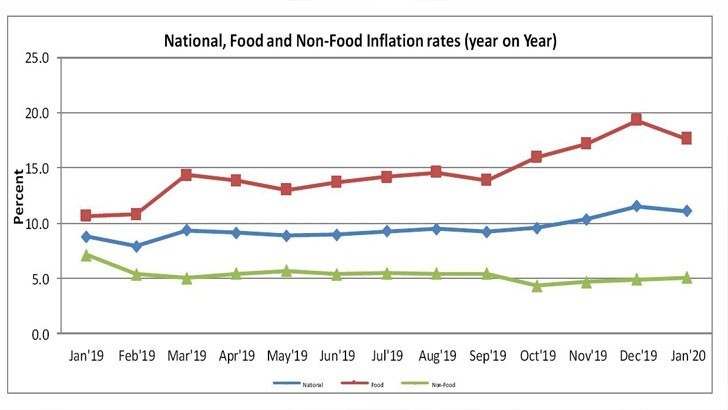Declining food price Eases inflation rate
Declining food prices eased January inflation by 0.4 percentage point from 11.5 percent recorded in December to 11.1 percent in January, published National Statistical Office (NSO) figures showed on Wednesday.
The rise in non-food inflation, from 4.5 percent in December to 5.1 percent in January was offset by a significant decline in food inflation, which declined from 19.3 percent in December to 17.6 percent during the review period.

Catholic University dean of social sciences Gilbert Kachamba observed yesterday that inflation will further go down as the country nears the harvesting period.
“Although this is the case we, need to change the weights and the components of the consumer basket so that the inflation movements reflect what is happening on the ground,” he said.
Although maize production increased by an estimated 24.7 percent relative to the previous year, prices of the country’s staple grain have been on an upward spiral in the past months, currently trading at as much as K400 per kilogramme (kg), translating to K20 000 per 50kg bag in some parts of the country.
Stae produce trader Agricultural Development and Marketing Corporation (Admarc) has also been selling maize at K150 per kg, translating to K7 500 per 50kg bag.
Meanwhile, the first round crop estimates figures produced by the Ministry of Agriculture, Irrigation and Water Development show an increase in all crops such as cereal, legumes, roots and tubers, and livestock production, with maize, the country’s staple grain projected to increase by 8.8 percent from 3 391 924 metric tonnes (MT)in 2018/2019 growing season to 3 691 866 MT in the 2019/2020 growing season.
The increase is attributed to favourable weather conditions and increased uptake of inputs by farmers. An increased agriculture production is good news to the economy, whose growth depends more on the performance of the agriculture sector.
Minister of Finance, Economic Planning and Development Joseph Mwanamvekha has maintained the seven percent growth rate, saying it will be pushed up by planned infrastructure development and continued focus on growth potential sectors such as agriculture.
The ambitious projection is three percentage points above a growth rate of four percent achieved in 2018 and two percentage points above the 2019 projected real GDP growth rate of five percent. The projection is also below World Bank’s 4.7 percent, IMF’s five percent, EIU’s 4.4 percent and AfDB’s 5.2 percent.
Reserve Bank of Malawi (RBM) spokesperson Mbane Ngwira said basing on the estimates, the central bank expect food prices in general and maize prices in particular to be stable adding, “if this is achieved, we expect to achieve our inflation target of 8.8 percent for 2020”.
Treasury spokesperson Davis Sado said the projected good harvests will result in increased economic growth as the sector provides income to many rural people, boosts transport sector, is a raw material for manufacturing firms and attributes to low inflation hence low prices for most commodities.





